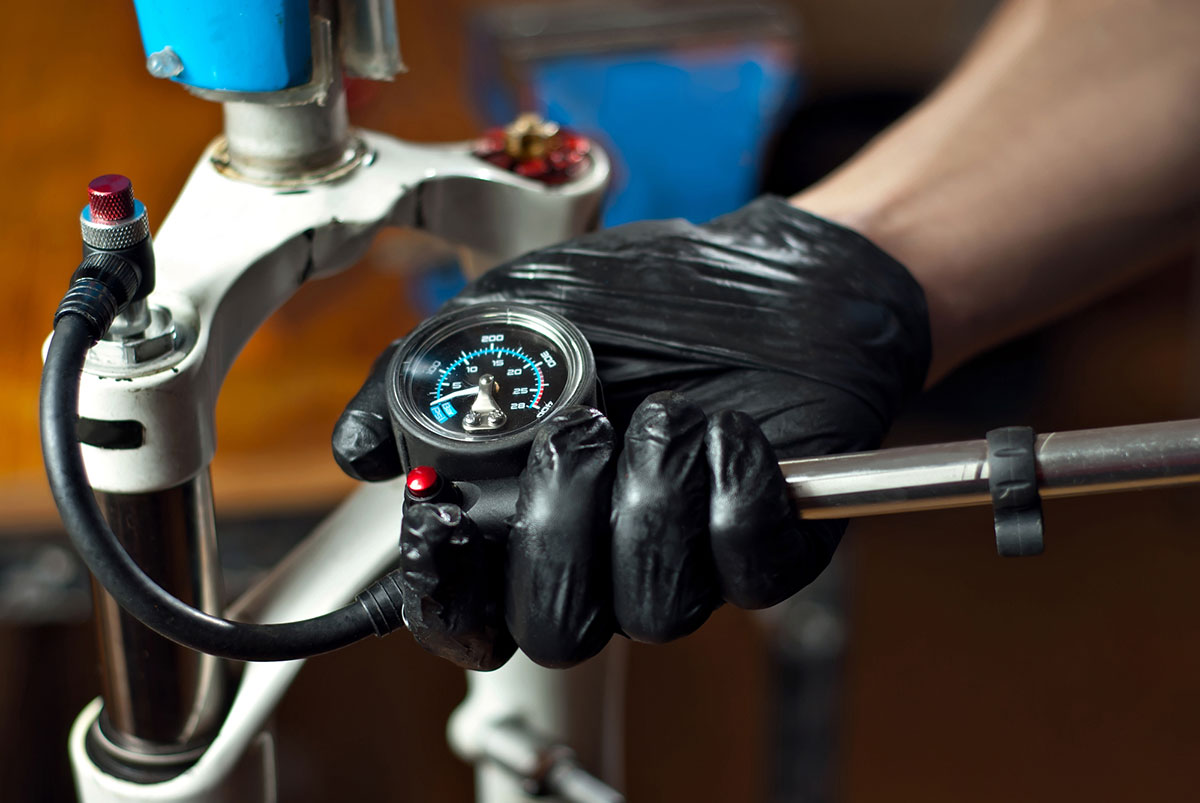
There is no easy answer to this question. Before we can begin, you should know that there are two service categories for mountain bike suspension. The first is a lower leg service required roughly every 50 riding hours, and the second is a more comprehensive damper service approximately every 200 riding hours.
However, there are always exceptions, as with anything in life, no matter how you slice the dice. The same is true for the question of how often you should service your mountain bike suspension.
Common mountain bike suspension brands include RockShox, Fox, Marzocchi, and SunTour, all of which have varying service intervals. Marzocchi forks and shocks require a service every 125 hours, and Fox is 30 hours for a lower leg service for air shocks and forks and 100 hours for a damper service. Conversely, a Fox coil shock needs servicing every 100 hours.
My personal favorite RockShox rides with the pack coming in at the accepted baseline of every 50 riding hours for a lower leg service and 100-200 riding hours depending on the component for a fuller service. SunTour is so prolific in the market that it is recommended that you check their website for your specific shock or fork.

What to Consider
There are several factors to consider when it comes to keeping your mountain bike’s suspension in tip-top shape.
Brand
The model and brand of suspension you use is your most important point of reference. Bike suspension suppliers will have the specs and suggested service hours listed on their website or owner’s service guide, and if they don’t, they should.
Failing that, whoever you purchased it from, whether new or secondhand, should know or be able to direct you to their preferred service center for guidance. Always use a reliable service provider or local bike shop, aka LBS.
Mountain bikers, in general, seem to be a friendly lot. They always want to welcome someone else into their club (cult) of mountain biking. Don’t be afraid to ask. I did. Better yet, make friends with the mountain biker who tinkers; this person will be able to give you a knowledgeable opinion.
Riding Conditions and Style

If you regularly ride in extreme weather conditions, including heavy mud and dust, more regular services are wise. The shocks that form part of your suspension absorb the extra uncomfortable lumps and bumps, so they will need TLC if they are being pushed to the max on rough terrain. The other purpose of your suspension system is to provide better traction on the trail.
The Warning Signs
There are other reasons for servicing your suspension before the required hours are up. These include your bike not riding right, and you should be on the lookout for the following symptoms.
- Dryness, the stanchion on your fork or rear air shock should always have a thin film of oil, but be warned changing the oil and seals while straightforward is not for the inexperienced.
- You are experiencing greater friction during your ride – it’s less comfortable, and your fork feels sticky.
- The fork is losing air or oil, and both are a sign of a damaged seal.
- Bubble noises in your rear air shock
- Creaking or clicking noises as the suspension compresses could mean the pivot bearings need replacing.
If you are experiencing any of these, your bike probably needs a tune-up.
What to Expect From a Service
Mountain bikes fall into one of two main categories. The first category is the hardtail which has front suspension, and the other is the full suspension, which has front and rear suspension. If you are servicing or having your mountain bike serviced, you are servicing the shocks, the fork, and the pivots.
The shock and the fork both have two main parts. These two parts are the damper and the spring. If you are doing a damper service, then you will replace the oil in the damper and most of the seals. You can buy service kits that include all the seals that need replacing if you intend to do it yourself.
Be sure to let the air out of your air shock before attempting any maintenance yourself. YouTube is an excellent resource if you need some advice.
If it is only a lower leg service and not your damper service, you might get away without replacing any major parts. On the lower leg service, you will likely have to replace only the wiper seals and foam ring (if you have them) on your fork. This is the seal responsible for keeping the dirt out of the fork, and replacement depends on the condition.
While servicing your rear suspension, the technician will check your pivots for any play and replace the pivot bearings if necessary.
Everything will be checked and cleaned on your suspension system from top to tail.
It is vital to keep your bike clean. Wiping off and cleaning your bike regularly, including the fork and shocks, goes a long way in preventing impurities from getting into the piston fluid. Manufacturers generally recommend that you wipe the stanchions down with a cloth or paper towel every ride.
The Takeaway
Your takeaway for maintaining and servicing your mountain bike suspension is that it is a lot like having a car. You do certain things every time you ride, some maintenance every few months, and your bike should be serviced at least once a year, depending on how hard you shred the gnar. Using the baseline of 50 riding hours for a lower leg service and 200 riding hours for a damper service is a good rule of thumb.
Sources:
